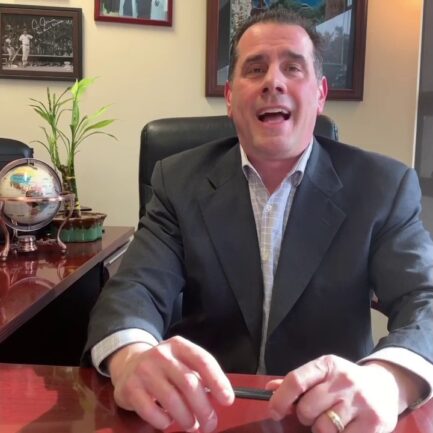Come on
warm lead. This is George G. And the time is right. welcome today’s guest strung apart for rich cast Barian. Rich, are you ready to do this?
Rich Kasparian 0:20
Absolutely.
george grombacher 0:21
Alright, let’s go. Rich is the president of Garden City Financial Group. He’s working passionately with individuals, families and businesses to manage and help them pursue their financial goals. Rich, tell us a little bit my personal life’s more about your work and why you do what you do.
Rich Kasparian 0:41
Yeah, rich Kasparian. That’s who I am. I was born and raised in the Bronx, New York, moved out to Long Island, probably about 30, some odd years ago, married with three kids
worked.
And in 2009, when things were collapsing, so to speak, after the financial crisis, I was working with Smith Barney for many years. And I decided to go into my own practice, which I’ve done now for the last 12 years, successfully. And the big basis of my business is not only, you know, trying to point clients in the right direction to enhance their portfolios, but protect their portfolios, especially in downtimes.
george grombacher 1:35
Yeah, I think it certainly strikes me that when things are going great, makes it a little easier. And it’s more fun to check our portfolios and our investments and all that. But when things get a little choppy or tumultuous, however you want to say it, that’s when fear tends to grip us and then our human brains, which are great, tend to lead us astray a lot of the time.
Rich Kasparian 1:57
That’s correct. That is the way it generally goes.
george grombacher 2:03
So I there’s that one size fits all, but I don’t know the best way to sort of jump into it, but how how do you help people protect against risk?
Rich Kasparian 2:17
Well, you know, the general theme in, in my side of the business is, is diversification, that’s what you hear, you know, nonstop from most financial advisors? Are you diversified? Are you diversified? Well, what does that really mean?
Diversification in simple terms to most people, or most even financial advisors, is how was your portfolio structured? Okay, so how much of what you own is equities, or stocks, and how much of what you own is fixed income, or bonds or cash. And they devise this sort of strategy whereby if a person is a certain age, they’ll determine what the percentages on each would be. So if they were relatively young, you know, they would have maybe 70% in stocks or equities, but 30%, in bonds, and so on, and so forth. So that is sort of the age base, one size fits all in the business. I sort of take a very different approach, because there’s there there are times when bonds could be down, and stocks could be down or bonds could be up, and stocks could be up. We don’t even know typically, they work inversely, they don’t always the market has been its own species for about the last 15 years. We’ve had times where we saw commodities, bonds and stocks go up in parity. So what I typically do is there are programs out there that are built, whereby you can have upside in the market, but have downside protections, meaning some sort of a barrier, a buffer. Now, the old argument in this theory was that if you did that you were sacrificing so much upside. So in other words, if I wanted to protect my my assets in the old days, you were sacrificing this huge amount of upside, so it wasn’t worth it. Well, those days have changed and they’ve sort of progressed over the last 1520 years. So there there are programs, you know, that allow you to capture the upside of indexes like the s&p 500, the Russell 2000, the NASDAQ 102 Dow Jones, and there are programs out there they’re called structured notes. These are bonds that are built to capture indexes on the upside, but they give you a very big downside protection. So if that insured and those indexes did not perform, you have a large downside protection Which means the house has to put the money back in to the bond to the account to make you whole or somewhat whole. There are other programs that are available through many insurance companies, annuity based programs, where they’ll provide you an income, some cases and income for life. Or they’ll provide you downside protection if you have one of the growth programs. So that’s how it’s really done. And in a lot of these programs, you could still select, hey, how many how much do I want and bonds and how much they want and stocks? But it is a actual true downside protection.
george grombacher 5:38
Got it? So when you talking to clients, potential clients about indexes, how much of that is grasp? And how much goes over goes over people’s heads?
Rich Kasparian 5:50
Well, that’s a great question. Because back in, you know, years ago, and um, you know, I’ll see even say, 15 years ago, you know, person would come in, and did you see the Dow today, you know, it was all about the Dow, and the comical part of the Dow is it’s 30 stocks. So 30 stocks have driven our brain for, you know, 100 plus years, you know, and that’s sort of that has changed, because you do hear people speaking much more about the s&p 500, which have 500, large US companies, Russell 2000, which you you’re smaller 2000, you know, stocks. So it has it has somewhat changed beyond the old story of the Dow and the Nasdaq. So they, they’re, they definitely understand that more, and a lot of even mutual funds or a lot of investments now are tied more to indexes. You know, you see a lot more of that now. With with the investors on the standard. Got it.
george grombacher 6:53
Nice. That makes sense. Fascinating, right? The Dow stock market’s crashing the stock market’s way up? Well, kind of,
Rich Kasparian 7:02
yeah, know exactly, you know, the s&p, I would argue, is probably a bigger indicator, but they generally trade in parity, the the Russell is sort of a different animal. Because what typically happens when you have smaller stocks or smaller companies in a recovering economy, they usually lead the way. But But, but what you know, like, currently, right now, let’s say the Dow right now is about 8% off the high give or take. The s&p Maybe right now is about six to seven off, its I, the the Russell is probably down since November, like 16% off its high. So a lot of times, what you’ll see is the rustle could be like an indicator of what’s coming, whether it be you know, potentially be up or down, you will see that a lot.
george grombacher 7:51
Interesting. So you’re talking about how used to be that I wrote down, the juice wasn’t worth the squeeze. So you wanted to participate? And upside, you want to dump downside protection, but I’m guessing that sounds like the cost was too high. And it strikes me that anytime that we’re trying to make decisions about if it’s the kind of investment that the investment vehicle or product, or whatever it is, we just need to make an educated and informed decision about this is the cost, the fees, the whatever expenses are part of this program that I’m looking at, and this is what it gets me.
Rich Kasparian 8:30
Yeah, absolutely. You know, that is, that is the absolute case. You have to sort of weigh everything out. You know, in many in many of the programs, you know, there are there are costs associated with protection. Some of them now, some of them it is it is built into the the program. But the case of that is, you know, and I’ve always said this to people, if they say, Well, geez, this program has a higher fee than, say a mutual fund. And I would say yes, it is. But the risk is if you drive the car down the street without insurance, would you do it? And most people say no, if they’re having an accident, I can have insurance Plus, I’m not allowed to. It’s the same so so why wouldn’t people have sort of insurance or some sort of protection for their investments even even if it means a cost? Now, when we evaluate portfolios, we don’t charge anything that’s all part of our business at Garden City Financial Group. So evaluating portfolios, doing an analysis, that’s all included, what I will say coming back to diversification, and we see a lot of when we’re managing or not managing reviewing people’s portfolios is what you’ll see is they say I’m diversify. Forgetting the protection for a second I’m a die of Have a diversified portfolio. And then when you start to look at their statements and see how they were set up, say, Oh, I’m diversified, I own 10 mutual funds in my 401k retirement plan? Well, the problem is, is that a lot of funds have different names are nice little fancy names. So it’s a large cap fund or a growth fund. And then when you drill down, the amazing part of it is many of them all on the same stocks. So I had a client a few years back, I’m diversified. And we literally took a highlighter, we did a printout of all of the funds. And we literally took a highlight highlighter, and what we found was all of them on Microsoft, all of them on Amazon, all of them on Facebook. So when you when you really broke it down, you saw that, you know, they have different names a lot of these funds, and unless you really drill down, you wouldn’t even know it.
george grombacher 11:03
Yeah, it’s it’s, it’s it’s pretty wild. How that is the case. And I think that most people would be really surprised by that. Because yeah, there’s all these different to your point, all these different names and packaging for products that probably end up being fairly similar, but we don’t know until we know. And the only way we know is if we actually look and dig into everything. Like that. That’s that’s one of the problems with with the financial services, the world of personal finance is just so many terms and so much jargon and so much sort of unnecessary complexity. And I think you’ve done a great job sort of breaking down the misnomers when it comes to diversification, when you’re talking to people about risk and risk tolerance, that that’s also one of those sort of black boxes. It’s like, okay, I know that I’m supposed to have a risk tolerance, but what does that really mean? And how do I figure out what my real risk tolerance is?
Rich Kasparian 12:01
Yeah, that mean, that’s a great question that I look at it sort of as two directions, a lot of advisors, what they will do is they will sort of give you this little questionnaire, and you know, try to determine your, your, your feelings on it, and and they’re available out there. I look at it more from emotion. Because that’s really what risk tolerance says. So if, you know, I’ve said to new prospects, or customers or potential customers, if that statement comes in the mail and the market is down, do you open the envelope? Do you slowly open the envelope? You tear it in half? Or do you bury it until you think the market is up? That predicates, as crazy as this myth, sound, and so juvenile, but it really does predicate the person’s risk tolerance and what they can handle, if they can open that envelope, or every time they turn that computer on and see where their portfolios if they’re in a panic, then then you have to say, as a financial advisor is, you know, how does what, what is the way? What is their risk tolerance? Is it moderate? Is it totally conservative. The other thing I do that I think is very different, and we do as a whole, as a firm is we work backwards, so many advisors have a customer came in and said I have X amount of dollars to invest. Unfortunately, there are a lot of advisors, let’s say the number was $50,000, I’m just throwing out a number. An advisor would come in and determine how much liquidity they have, but would say okay, you have 50, let’s invest 50,000. What we do, we work backwards. So I’ll say to a person, okay, this is what you have liquid. How much of that? Do you want to invest? Do you have money for a rainy day, because the goal is and investing is you want to sort of lock it up. You want to tuck it away, you want to make sure it’s there. And then we could make sure we have protections on money. But if there’s not enough money in the bank, then you’re kidding yourself. Because what happens is then when the customer needs money, they have to dip into that investment. If the markets down, they might they could potentially be losing money at that point. So those are two of the ways we sort of work with risk tolerance. Number one, what’s your cash position first? And then number two, what’s your emotion tied? How closely tied are you to your portfolio, emotion wise and what you know, what can you handle when we’re trying to set up a portfolio?
george grombacher 14:47
I think that that’s a great approach. Certainly, one of the least exciting areas of maybe anything is just making sure you have enough cash set aside. And that’s right. Sure you get questions all the time, isn’t there an opportunity cost to just not having that invested?
Rich Kasparian 15:06
Right? I’m sure I mean, you, you, you know, like, I’ll say to people, why, but I’m not making any money in the bank, you’re not. And it’s terrible for but it’s there. And that’s just sort of the cost of doing business, you want to make sure the goal is not to have to dip into your long term and or even mid term investments, and having enough for that day where if you need the extra cash, it’s there.
george grombacher 15:34
Yeah, going back to your car insurance analogy, and the price that you’re paying for needing money and not having the value of your emergency fund have gone down by 40%. Because the market went down by 40%. That’s the premium that you’re paying for your car insurance is just missing out on a little bit of opportunity cost.
Rich Kasparian 15:53
So that’s right. Yep.
george grombacher 15:54
I like it. I love your analogy about how you respond when the markets down? Or do you do when you when the statement comes in the mail? I think that that’s, you just need to be really, really honest with ourselves.
Rich Kasparian 16:07
Now you do. And just coming back to the liquidity. The people will often say to me, Well, that’s a hot question. How much liquidity do I need? I’m not sure. You know, and there’s a lot of formulas out there six months of bills. But for a lot of the you know, uncredited type investors we dealing with, you know, that they’re not, you know, they’re not living check to check so to speak. So in that realm, the number is different. It was a funny, quick story. Some years ago, we I had a customer who kept an enormous amount of money and liquidity, literally making zero, he was purchasing treasury, treasury bills, which were practically zero. I mean, the joke was the government, you’re paying the government to keep your money versus the other way. And it was that the funny joke was, it was $4 million. And every month that would come. And he would just say, roll it over, roll it over, roll it over, and we buy 30 day treasury bills at basically a 0% interest rate. And the joke was, you know, at some point, I said, Are you going to buy a big house in the Hamptons next month? What what do you, you know, and he would laugh, and they would say, roll it over. So his threshold, his liquidity number in the bank was 4 million. And like I said, for everybody, it’s a different number. You know, it could be 50,000. It could be in his case, 4 million, it depends on the investor.
george grombacher 17:36
Yeah, I like it. You know, in a perfect world, there’d be perfect ideal situations, but we don’t live in a perfect world. And we need to be able to sleep at night and not develop horrible ulcers. So yes, figuring out what’s right for you is such a key thing. Rich people are ready for that difference making tip, what do you have for them?
Rich Kasparian 17:55
I think the different difference making tip is when you look at your portfolio, you have to say to yourself, let’s say you’re nearing retirement, you have to say to yourself, where’s my portfolio at? And if I want to retire? You know, next week? What would happen if the market had a major downturn? We saw this in oh one, we actually 2000. And we saw this in a way again, you know, where if that person was going to retire when nearing retirement, that money, they thought they had basically eroded? And they weren’t like the 45 or 50 year old that had time to say, hey, the market will come back, don’t worry about it. So, you know, that’s sort of where we come in, and we can look at protections and we can look at ways to evaluate those portfolios and say, Okay, this is what we can do to sort of put an umbrella around the investments so that would I you know, that’s what I think we can do on a website, by the way is WWW dot Garden City financial group.com There’s a lot of good information, there’s videos, we have a blog, and of course, you know, anyone could contact us if they have any further questions.
george grombacher 19:11
Well, I think that is great stuff that definitely gets caught. Mitch, thank you so much for coming on. Appreciate you. Give us the website again.
Rich Kasparian 19:20
www dot Garden City financial group.com
george grombacher 19:25
Perfect. Well, if you enjoyed as much as I did show risk, rich your appreciation and share today’s show with a friend who also appreciates good ideas, go to Garden City Financial Group calm and check out other great resources and get in touch with rich.
Rich Kasparian 19:40
Thanks again. Thank you joy. It’s great to be with you.
george grombacher 19:43
And until next time, keep fighting the good fight. We’re all in this together.
Transcribed by https://otter.ai





